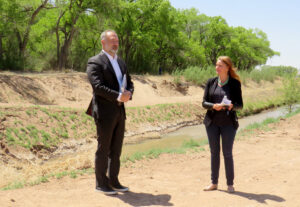EPA issues roadmap for addressing PFAS contamination

The U.S. Environmental Protection Agency released a roadmap for addressing PFAS, a group of forever chemicals that have contaminated air, water and soil across the United States.
“For far too long, families across America – especially those in underserved communities – have suffered from PFAS in their water, their air, or in the land their children play on,” said EPA Administrator Michael S. Regan in a press release announcing the roadmap. “This comprehensive, national PFAS strategy will deliver protections to people who are hurting, by advancing bold and concrete actions that address the full lifecycle of these chemicals. Let there be no doubt that EPA is listening, we have your back, and we are laser focused on protecting people from pollution and holding polluters accountable.”
PFAS, or per-and-polyfluoroalkyl substances, are also called forever chemicals because they do not break down under normal environmental conditions. PFAS chemicals are man-made and use of them dates back to the 1940s. During the decades following their invention, they have had little to no regulation. There are thousands of chemicals that are considered PFAS.
On Monday, in addition to releasing the roadmap, the EPA announced a new national testing strategy. This requires manufacturers of PFAS to provide the EPA with toxicity data and information on categories of chemicals. According to a press release from the EPA, the PFAS that will be tested will be selected “based on an approach that breaks the larger number of PFAS today into smaller categories based on similar features and considers what existing data are available for each category.”
An initial set of test orders is expected in a matter of months and will select from more than 20 different categories of PFAS, the press release states.
These forever chemicals can lead to a variety of health impacts including impacting childhood development, reducing people’s ability to get pregnant, interfering with hormones and increasing the risks of certain cancers.
“Every level of government—federal, Tribal, state, and local—needs to exercise increased and sustained leadership to accelerate progress to clean up PFAS contamination, prevent new contamination, and make game-changing breakthroughs in the scientific understanding of PFAS,” the EPA road map states in its conclusion.
The road map lists a series of actions that the EPA will take and a time frame for these actions to occur, including outreach to impacted communities and public education efforts as well as designating PFAS as a hazardous substance under the Comprehensive Environmental Response, Compensation and Liability Act. This act allows the federal government to clean up sites that have been contaminated and is sometimes referred to as the Superfund Act. A White House Fact Sheet released Monday about the roadmap states that the CERCLA designation will allow broader and faster cleanup of PFAS contamination and the EPA press release states that it will “strengthen the ability to hold polluters financially accountable.”
The designation as a hazardous substance is one of the things New Mexico leaders including the governor have pushed for. In June, Gov. Michelle Lujan Grisham petitioned the EPA to list PFAS chemicals as a hazardous waste under the Resource Conservation and Recovery Act.
In New Mexico, PFAS has received attention after fire suppression foam used in training exercises at military bases led to contamination of groundwater that neighboring communities relied on.
In the roadmap, the EPA states that it will hold polluters accountable and lists military bases as one such polluter. The roadmap further calls for prioritization of disadvantaged communities such as low-income and minority communities, which are more likely to be near contaminated areas such as military bases, airports, industrial facilities and waste-management and disposal sites.
A final rule for monitoring PFAS in groundwater is expected this fall and the EPA plans to establish national primary drinking water regulations for two types of PFAS next year.
The roadmap also includes public engagement and the EPA will meet with impacted communities in every region. The agency will also work to educate the public about the dangers of PFAS.
A fact sheet released by the White House states that the U.S. Department of Defense is “moving swiftly to address PFAS” at military sites throughout the country, which includes conducting cleanup assessments at more than 700 Department of Defense installations and National Guard locations.
PFAS has many other uses as well, including being common in household cookware and being used to treat carpet and upholstery. PFAS is also used in the oil and gas industry.
Earlier this year, Physicians for Social Responsibility issued a report detailing how chemicals that could break down into PFAS have been used in fracking operations in New Mexico as well as other states. This has led to concerns that PFAS could be in produced water, also referred to as wastewater from oil and gas operations.
This article was originally posted on EPA issues roadmap for addressing PFAS contamination







